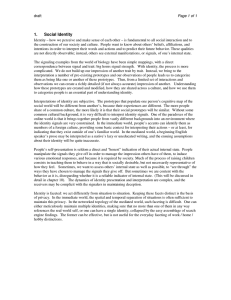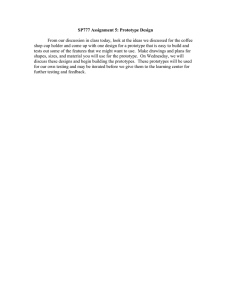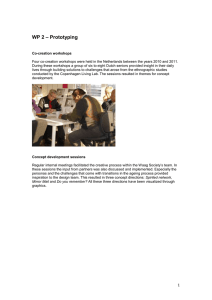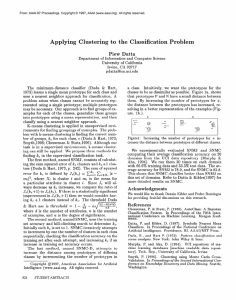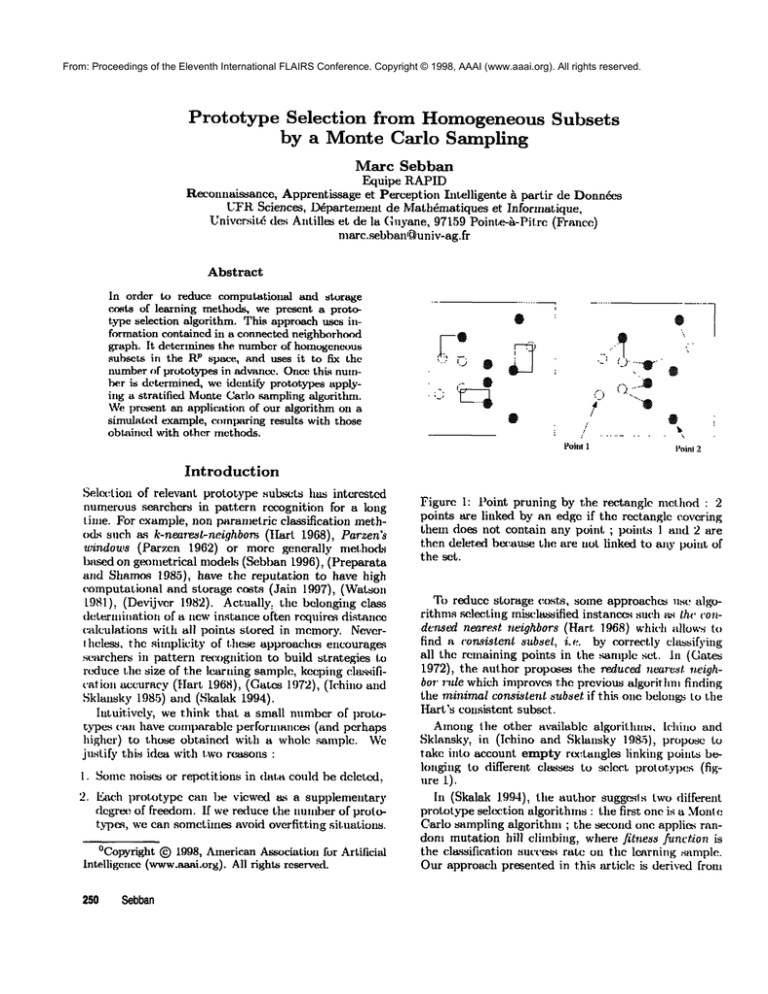
From: Proceedings of the Eleventh International FLAIRS Conference. Copyright © 1998, AAAI (www.aaai.org). All rights reserved.
Prototype
Selection
from Homogeneous Subsets
by a Monte Carlo Sampling
Marc Sebban
F~uipe RAPID
Reconnaissance,
Apprentissage et Perception Im.elligente
~ partir de Donn&~
L-FR Sciences, Ddpartement de Mathdmatiques et Informatique,
Univcrsitd des Antilles et de la Guyane, 97159 Pointe-~-Pitre
(France)
marc.sebbanc.~,un iv-ag, fr
Abstract
In order to reduce computatiomd
ald storage
c~stsof learningmethods,we presenta protot.,~T)e
selection
algorithm.
Thisapl)roach
usesil,formation
contained
in a connected
neighborhood
graph.It determines
the numberof homogeneous
subsetsin the Rp space,and usesit to fix the
numberof prototypes
in advance.Oncethisnumberis determined,
we.idcntii~,"
prototypes
applyinga stratified
MonteC~rlosampling
algoritl,n,.
We. prc~ent
an application
of our algorithm
olla
simulat(xl
example,
comparing
results
witilthose
obtainedwith othermethods.
Introduction
Sel(x.tion of relevant prototype subsets has interested
mlmerous se’~rehcrs in pattern recognition for a long
time. For example, non parametric classification
methods such as k-nemwt-neighbors
(tIart
1968), Parzen’s
¯ u~indou,s (Parzen 1962) or more generally
methods
ba~d on geonmtrical models (Seb~mn t996), (Preparata
and Shamos 1985), have the reputation
to have high
computational and storage costs (Jain 1997), (’~Vatson
1981), (Devijver 1.082). Actually.. the belonging class
determitmtion of a new instance often rcquire~ distanoc
calculations
with all points stored in memory. Neverthcless, the simplicity of these approach(~ encourages
searchers in pattern re(u~gnition to build strategies to
r(xluce the size of the learning sample, kec~fing cla.~sification accuracy (Hart 1968), (Gates 1972), (Ichino
Sklansky 1985) and (Skalak 1994).
Intuitively,
we think that a small number of protocypes can have comparable performanc~ (and perhaps
higher) to those obtained
with a whole m~mplc. We
justin’ this id~x with two re~asons :
I. Some noises or repetitions
2.
in data could be deletcxl,
~t(’h prototype can be viewexl a~s a supl)lementary
dcgrcx ~, of freedom. If we rex|uce the mmlber of prototype~, we can sometimes avoid overfitting
situations.
°Copyright ~) 1998, American Association for Artificial
Intelligence (www.aaai.org). All rights reserved.
250 Sebban
Figure. 1: Point pruning by the rectangle method : 2
points are linked by an edge if the rectangle covering
them does not contain an)" point ; points l and 2 are
then deleted because the are not linked to any poiut of
the set.
To reduce storage, costs, some approachc~ us( r algorithms ~leeting misclassified instances such ~-~ the condensex/ nearest neighbors (Hart 1968) which a/low.s
find a consistent subsel, i.e. by correctly classifying
all the remaining points in the sample set. In ((.lares
1972), the author propos~ the rexl.uced ncare..~t neighbor rule which improves the previous algorithm finding
the minimal consistent ~ub~et if this one 1)elon~,~ to the
Hart’s consistent subset.
Among lhe other available
algorithms,
lchino and
Sklansky, in (Iehino and Sklansky 1985), propose
take into account empty r(x’tangles
linking points belonging to different classes to select prototyl)cs (figure 1).
In (Skalak 1.994), the author suggcsls two diiferent
prototype sekx:tion algorithms : the first one is a Mon!c
Carlo sampling algorithm ; the second one applic~ randora mutation hill climbing, where fitness fu.nctio.n is
the classification SllC(’(~.~s rat(: on the lc,’trning .~ample.
Our approach presented in this article
is derived from
the first one. This is the reason whywe briefly review
in tim next section the useful aspects of the Skalak:s ~lection algorithm. This method being limited to simple
problems where clasps of patterns are easily" separable,
we propose in section 3 an extension of the principle
which determines in ad~ance the number of prototypes
from a connected neighborhood graph. In order to show
the interest of our approach, we apply the algorithm on
~,n examplein section 4.
The
Monte
Carlo
Sampling
Algorithm
Thc principle of the Monte Carlo method is based on
rcpcated stochastic trials (n). This way to proceed allows to approximate the solution of a givcn problem.
In (Skalak 1994), the author suggests the following algorithm to determine prototypes. The number of prototypes (m) is fixed in advance as being the number
classes to learn.
I. Select. ’n random samples, each sample with replacement, of m instances from the training set.
2. For each sample, compute its classification accuracy
on the training set, using a 1-near~qt neighbor algorithm (Cover and Hart. 1967).
3. Select the sample with the highest (:htssification accuracy on the training set.
Homogeneous
Subsets
Extraction
and
Prototypes
Selection
Wethink that performances of a learning algorithm,
whatever the algorithm may be, depends necessarily
on geometrical structures of classes to learn (figure 2).
p,
Thus, we propose to characterize these structures in R
called homogeneoussubset.s, from the construction of a
connected neighborhood graph.
Definition 1 : A graph G is composed of a set of verticea noted ~ linked by a set of edgez noted .4 ; they a~?
thus the couple (VZ,A ).
Definition 2 : A graph is considered conne~:tc~ if, for
any couple of point,~ {a, b} E E’~, there exists a s<a’ies of
edges joimng a to b.
Wcautomatically deternfine the number of prototypes applying the following algorithm :
1. Construction of the minimumspanning tree. This
neighborhood graph ks connected and toni ains the
nearest neighbor of each point (figure 3).
4. Cla.ssi~. the test set using as prototypes the sample
with the highest classification ac~curacy on the training set.
This approach is simple to apply, but. t.o fix m as
being thc numberof classes is restrictive. Actually, it
is limit, ed to simple problemswherecla.-~ses of pat! erns
are easy to separate. Wecan imagine some problems
where the m classes are mixtxi, and where m prototypes
are not sufficient. In the next section, we propose an
improvement of this algorithm, searching for the number of protot~2~es in ad~ncc, and applying afterwards
a stratified MonteCarlo sampling.
Figure 3: Mininmm Spanning qYee (MST) : in this
graph the edge len~h sum is minimum. Froln n points.
thc MSThas ~dwavs n-I edges.
2. Construction of homogeneoussubsets, deleting edges
connecting points which belong to different, chtssc,~
(white and black). Thus, a homogeneoussubset is a
connected sub-graph of the MinimumSpanning Tree
(figure 4).
®
Figure 2: Examples of geometrical structures : on the
one trend, the first example (a) shows a simple probleln
dealing with 2 classes (black and white). These classes
arc represented by two main structures of points belonging to the same class ; on the other hand, the second example (b) shows mixed classes, with numerous
geometrical structures.
¯
®
-
.-?’J
....
Figure 4: Homogeneoussubsets
MachineLearning251
Tile number of homogeneoussubsets seems to characterize the complexity to learn classes of patterns. Thus,
the more this number is high, the more the number of prototypes must be high. Actually, when the
problem is simple to learn (figure 2.a), a small number
of prototypes is sufficient, to characterize all the learning set.. On the contrary, when the problem is (x)mplex
(figure 2.b), the numberof prototypes converges on the
number of learning points. Thus, we dcx:ide to fix the
mnnber of prototypes in a(l~nce as being the number
of homogeneoussubscls. Afterwards, we search for the
best instan¢x~ of each homogeneoussubset, to identi~’
its protot.~33e. To do t.hai, we apply a stratified Monte
C.arlo sampling.
¯ ¯
++
.
] Success
Rate
Yl%
55% ]wholeset
73% ]
] m----32
]m--2
Table l : Results obtained on a ~diclat.ion set : the first.
columncorresponds to the sucz.e.~s rate obl.ain(xl with
our procedure ; the second corresponds to t, hc. Skalak’s
method, and the third one to the succc,~s rate o})tained
wit.hout reduction of the learning set
Results
In order to show the interest of our approa(’h we want
to verify that the rexluction of the learning set ¢1o~
not reduce significantly the revognit.ion perforntance~ of
the model built on this new learning sample. Wenmst
verify that the success rate obtained wit h the sub.set is
not significantly weakert.han Lhe ont: obtained wit h the
whole sample.
Applying our algorithm of homogent.~ms sub~,t extract:ion, we obtain m = 32 structures (figure 6). l{e,sults are presentedilL tit(; table 1, with ’n = I(X) t.rials.
This experiment shows that our algorithm allows to
obtain a large reductkmin sl orage, and results are (’lose
t.o those obt.ained with the wholelearning ~;t.. The al)plicat, iol, of a frequency(xmlparison test doc~not. show
a significant difference between the two rates (7"1%vs
73%). On the contrary, we bring to thc fore. with tt,is
example the limits of the SLalak’s algorithm, where the
numberof prototyl)cs is fixed in advance~mt.h(" number
l"igure 5: Example with two classem and 100 points
Example
Presentation
Wcapply in this section our prototype selection algoril hm. Our problemis a simulation, with two classes (’q
and C2 (figure 5), where:
I. (Ti contains 50 black points : VXi E Ct,Xi =
N(p, a~
2. (."2 contains F~ white points ; VXi E C..2,Xi =N(p, a.2), where crI > a~.
With th(~e parameters we. wanted to avoid two cx! remesitua!ions :
1. Ihe 2 ¢’la.~es are linearly separal)le. In this (’~L~(: (loo
simple) 2 prototypes are sufficient.
2. the 2 classe,~ are totally mixed. In this ease (too complex) the tmmberof prototypes (?n) converges on
number of points (n).
The validation set is (’Oml)(rsed of 100 new ca~s,
extually chtxsen amongthe t~l~tr()
clas.~ C1 and C.~.
252 Sebban
Figure 6: .MininmmSpanning tree built on the training
sample ; edge~ linking points which belong to difforem
classes are deleted ; |hen, we obtain 32 holnogt’ll(~tnls
sulx~et.s.
Conclusion
D.B. 1994. Prototype and feature selection
by sampling and random mutation hill climbing algorithms. In Proceedings of 11th International Conference on Machine Learning, Morgan Kaufmann, 293301.
SKALAK,
Wethink that the reduction of storage costs of a learningse¢is close~"
related
to themixingof classes.
In
thisarticle
we haveproposed
to characterize
thismixing
by searching
forgeometrical
structures
(called
homogeneoussubsets)
thatlinkpointsof thesameclass.The
smaller
thenumberof structures
is,themorethereduction
of storage
costsis possible.
Themaininterest
of ourapproach
is to establish
a priorithereduction
rateof the learning
set.Oncethe numberm of prototypes is a priori fixed, numerous methods to select
them are then available : stochastic approaches, genetic
algorithms, etc. Wehave used a Monte Carlo sampling
algorithm to compare our approach with other works.
Nevertheless, we think that the I-nearest neighbor rule
is not always adapted to classes with different, standard deviation. Then, we are working on new labeling
rules which take into account, other neighborhood structures : Gabriel structure, Delaunaypolyhedrons, Lunes,
etc. (Preparata and Shamos1985). These decision rules
may allow to extract better prototypes from homogeneous subsets, using not only the I-nearest neighbor to
label a new unknown point but also the neighbors of
neighbors.
D. 1981. Computing the n-dimensional
Delaunay tesselation with application to voronoi" polytopes, The computer journal, (24):167-172.
WATSON,
References
COVER,T.M. AND HART, P.E. 1967. Nearestneighborpattern
classification.
IEEE"_lhzns.
Inform.
Theory
21-27.
DEVIJVER
P. 1982. Selection of prototypes for nearest
neighbor classification. In Proceedings of International
Conference on Advances in Information Sciences and
Technology.
GATES,G.~, r. 1972. The reduced Nearest Neighbor
Rule. IEEE Trans. Inform. Theory 431-433.
HART,P.E. 1968. The condensed nearest neighbor
rule. IEEE Trans. Inform. Theory 515-516.
[CHINO, M. ANDSKLANSKY,J 1985. The relative
neighborhood graph for mixed feature ,~riables, Pattern recognition, ISSN 0031-3~03, USA, DA (18):161167.
JAIN, A. 1987. Advances in statistical
tio~ Springer-Verlag.
pattern recogni-
PARZEN,E. 1962. On estimation of a probability density function and mode. Ann. Math. Stat 33:1065-1076.
F.P. AND SHAMOS, M.I. 1985. Pattern
recognition and scene analysis. Springer-Verlag.
PREPARATA,
M. 1996. ModUles thdoriques en Reconnaissance de Formes et Architecture hybride pour Machine
Perceptive. Ph.d Thesis., Lyon 1 University.
SEBBAN,
MachineLeaming253

